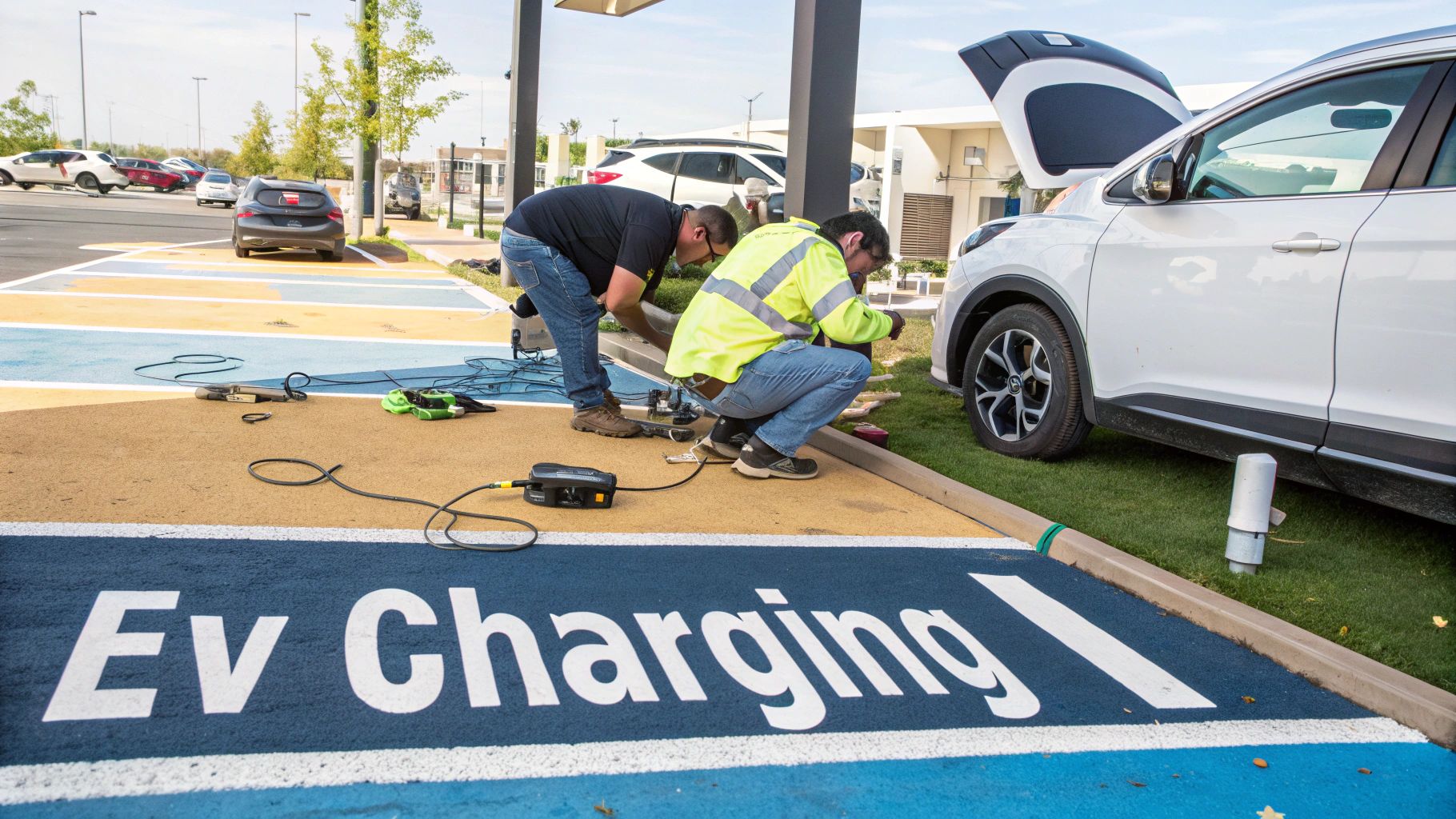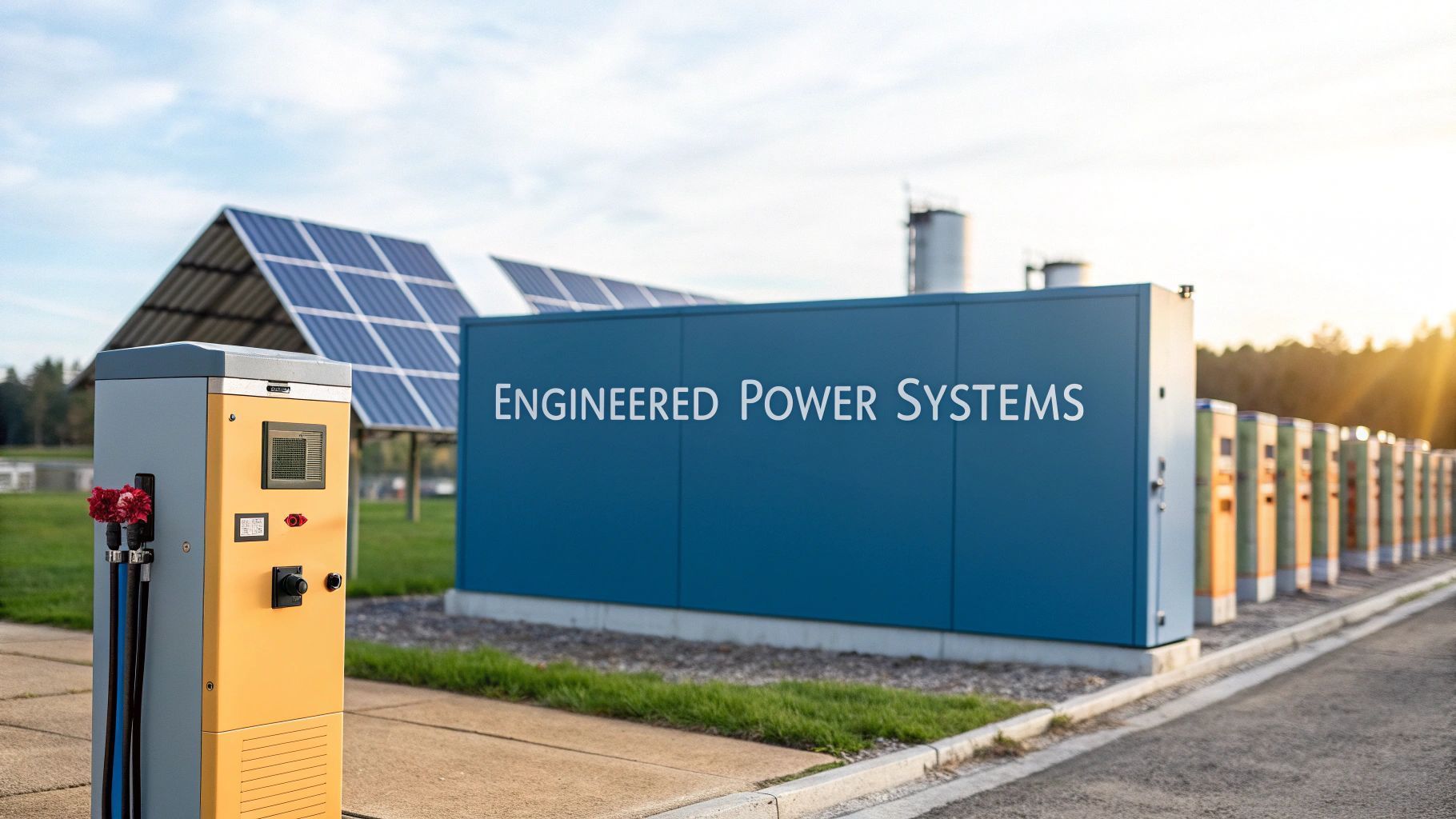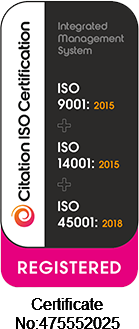8 Future-Proof Jobs in Sustainable Transport for 2025
The drive towards a net-zero future is radically reshaping the transport sector, creating a surge of exciting and impactful career opportunities. As the UK accelerates its transition away from fossil fuels, the demand for skilled professionals who can innovate, build and manage new energy ecosystems has never been greater. This shift is not merely about replacing petrol cars with electric ones but a fundamental re-engineering of how we power movement, presenting unique challenges and rewards.
From designing intelligent EV charging networks that work with constrained grid connections to integrating grid-scale batteries with on-site renewables, the industry is calling for a new generation of talent. The focus is on creating distributed energy systems where combined on-site renewables, EV charging and batteries work in harmony. This complexity requires specialised expertise and a forward-thinking approach to infrastructure development.
This article provides a detailed guide to eight of the most pivotal jobs in sustainable transport . We will break down the essential responsibilities, required qualifications and realistic salary expectations for each role. Whether you are an experienced energy sector professional, a government contractor or an innovator looking to make your mark, your next role could be instrumental in powering a cleaner, more resilient Britain.
1. EV Charging Infrastructure Engineer
As the transition to electric vehicles accelerates, the role of an EV Charging Infrastructure Engineer has become one of the most vital jobs in sustainable transport . These professionals are the architects of the new refuelling network, designing and implementing the systems that power electric cars, buses and lorries. Their work goes far beyond simply installing a charging point; it involves a holistic approach to energy management, grid integration and future-proofing our transport infrastructure.
This role is crucial for overcoming one of the biggest hurdles to EV adoption: deploying rapid EV charging, particularly where the grid connection is constrained. Engineers in this field conduct detailed site assessments, design charging layouts and manage the complex process of connecting to the electrical grid. They often integrate charging hubs with on-site renewables like solar panels and grid-scale batteries, creating a resilient and intelligent distributed energy ecosystem.
Why This Role is Essential
An EV Charging Infrastructure Engineer directly tackles the practical challenges of electrification. For commercial fleets or public charging networks, a weak grid connection can halt a multi-million-pound project. These engineers devise solutions, such as those pioneered by UK-based developers like ZPN Energy , which use integrated battery storage to deliver rapid charging power far beyond what the grid can supply directly. This allows for the installation of 150kW+ chargers in city centres, logistics depots and remote locations that would otherwise be unsuitable.
Practical Applications and Examples
- Fleet Depot Electrification: Designing and deploying charging infrastructure for electric bus or HGV fleets, ensuring vehicles are charged efficiently overnight without overwhelming the local grid, often from constrained grid connections.
- Public Charging Hubs: Engineering urban charging centres that use grid-scale batteries to buffer energy during off-peak hours and release it for rapid EV charging during peak demand.
- Mobile EV Charging Solutions: Creating transportable, battery-integrated charging units for events, emergency services or temporary vehicle depots.
Key Insight: This engineering role is not just about electrical installation; it's about distributed energy resource management. The goal is to build a charging network that is smart, responsive and capable of supporting the grid, not just drawing from it.
How to Pursue This Career Path
To excel in this field, a specific skill set is required:
- Gain Qualifications: A degree in electrical engineering is fundamental. You must also be proficient with the IET Wiring Regulations (BS 7671).
- Specialise in BESS: Develop deep expertise in Battery Energy Storage Systems (BESS), as they are key to overcoming grid limitations.
- Understand Grid Connections: Learn the intricate processes for connecting to the grid from constrained connections and the technical standards set by Distribution Network Operators (DNOs).
- Master Smart Protocols: Become familiar with smart charging software and protocols like the Open Charge Point Protocol (OCPP) which allow for intelligent management of charging networks.
- Build Your Network: Engage with industry bodies such as the Renewable Energy Association (REA) and leading EV charging technology providers.
2. Electric Vehicle (EV) Charging Infrastructure Specialist
Distinct from the pure engineering role, the EV Charging Infrastructure Specialist focuses on the strategic deployment, management and operational success of charging networks. They are the crucial link between technology, policy and the end-user, ensuring that one of the most essential jobs in sustainable transport translates into a seamless and accessible charging experience for everyone. Their work involves a broad spectrum of activities, from site selection and grid capacity analysis to managing software platforms and ensuring regulatory compliance, especially for rapid EV charging.

This role is pivotal in building out reliable public and private charging infrastructure, which is a key driver for EV adoption. Specialists analyse traffic patterns, local demographics and grid constraints to identify optimal locations for new installations. They work closely with local authorities, businesses and Distribution Network Operators (DNOs) to navigate the complexities of planning permission and grid connection agreements, turning strategic plans into tangible, operational charging points, including mobile EV charging solutions.
Why This Role is Essential
An EV Charging Infrastructure Specialist ensures the commercial and practical viability of charging networks. While an engineer might design the system, the specialist makes it happen by securing funding, managing project timelines and ensuring the final installation meets user needs and business objectives. Their expertise is vital for companies aiming to deploy thousands of charging points. They bridge the gap between technical possibility and real-world deployment, making electrification a practical reality.
Practical Applications and Examples
- Public Network Expansion: Identifying and developing new sites for rapid EV charging hubs along major transport corridors, working with partners like local councils and retail parks, often utilising grid-scale batteries.
- Corporate EV Fleets: Managing the rollout of charging solutions for commercial fleets, ensuring hardware, software and energy management systems (integrating EV charging and batteries) are fully integrated.
- Destination Charging: Collaborating with hotels, shopping centres and tourist attractions to install and manage charging points that add value for customers, leveraging combined on-site renewables.
Key Insight: This role is less about circuit diagrams and more about the holistic ecosystem of EV charging. It combines project management, commercial acumen and technical understanding to build networks that are not just functional but also profitable and user-friendly.
How to Pursue This Career Path
To succeed as a specialist in this dynamic field, you need a diverse skill set:
- Gain Certifications: Obtain industry-recognised qualifications like the Electric Vehicle Infrastructure Training Program (EVITP) to demonstrate your expertise.
- Master Network Protocols: Become proficient in the Open Charge Point Protocol (OCPP), the standard for communication between charging stations and central management systems.
- Understand Commercials: Develop a strong grasp of business models for EV charging, including demand charges set by utilities and potential revenue streams, particularly from systems combining EV charging and batteries.
- Navigate Policy: Stay current with government incentives, grants and regulations that influence charging infrastructure deployment in the UK.
- Build Relationships: Forge strong connections with DNOs, equipment manufacturers and network operators to streamline projects.
3. Mobility as a Service (MaaS) Product Manager
As cities seek to reduce congestion and reliance on private cars, the role of a Mobility as a Service (MaaS) Product Manager has emerged as one of the most innovative jobs in sustainable transport . These professionals are the visionaries behind the digital platforms that integrate various transport options, from public buses and trains to bike-sharing and ride-hailing, into a single, user-friendly app. Their work involves creating a seamless journey planning, booking and payment experience that makes shared and public transport more attractive than owning a car.
This role is pivotal for shifting consumer behaviour towards more sustainable choices. A MaaS Product Manager oversees the entire lifecycle of a mobility platform, from initial concept and user research to partnership integrations and feature roll-outs. They analyse vast amounts of data to understand user needs and optimise the service, ensuring the technology effectively glues together a complex ecosystem of transport providers.
Why This Role is Essential
A MaaS Product Manager directly tackles the fragmentation that often makes sustainable transport inconvenient. Instead of using multiple apps and payment methods, users can access a unified system. These professionals bridge the gap between technology, transport operators and city authorities to build a cohesive network. The success of platforms like Whim in Helsinki, pioneered by MaaS Global, demonstrates how a well-managed product can encourage a significant mode shift away from private vehicle ownership by offering subscription-based access to all city transport.
Practical Applications and Examples
- Integrated Urban Mobility: Managing apps like Berlin’s Jelbi, which combines over 15 mobility providers to give users a complete view of their travel options.
- Public-Private Partnerships: Leading collaborations between city transport authorities, like Transport for London (TfL), and technology firms to enhance public transit with on-demand services.
- Global Transit Platforms: Overseeing the growth of globally recognised apps like Moovit, which provides real-time transit data and multimodal journey planning for over 1.5 billion users worldwide.
- Subscription Model Innovation: Developing new business models, such as the Citymapper Pass in London, which offers a subscription for unlimited travel across various modes.
Key Insight: This product management role is not just about app development; it's about systems thinking and urban planning. The goal is to create a digital ecosystem that makes shared mobility so compelling and convenient that it becomes the default choice for urban travel.
How to Pursue This Career Path
To excel in this forward-thinking field, a specific skill set is required:
- Gain Product Management Skills: Obtain certifications like Certified Scrum Product Owner (CSPO) or Certified Product Manager (CPM) to master agile development methodologies.
- Understand Transport Networks: Develop a strong grasp of public transport operations, network design and urban mobility planning principles.
- Master Data and User Research: Become proficient in data analytics tools and user experience (UX) research to make informed, user-centric decisions.
- Learn API and Payment Integration: Build technical knowledge of how APIs connect different services and how secure payment gateways are integrated.
- Build Your Network: Engage with the mobility community by attending industry events like the ITS World Congress and joining organisations such as the MaaS Alliance.
4. Sustainable Aviation Fuel (SAF) Engineer
Decarbonising aviation is one of the greatest challenges in the global energy transition and the Sustainable Aviation Fuel (SAF) Engineer is at the forefront of this effort. This is one of the most specialised jobs in sustainable transport , focused on developing and implementing alternative jet fuels that drastically cut aviation's carbon footprint. These professionals work on multiple complex pathways, from producing biofuels using waste oils to creating synthetic fuels from captured carbon.
This engineering role is critical for the aviation industry's goal of achieving net-zero emissions. SAF engineers oversee research, manage pilot production facilities and ensure that any new fuel meets the exceptionally strict safety and performance standards required for commercial flight, such as ASTM D7566. Their work bridges the gap between chemical innovation and practical, scalable application for global airlines.
Why This Role is Essential
A SAF Engineer directly tackles the problem of emissions from long-haul flights where battery-electric solutions are not yet viable. They are instrumental in creating drop-in fuels that can be used in existing aircraft and airport infrastructure, avoiding the need for a costly, multi-trillion-pound overhaul of the global fleet. Companies like Neste are scaling up production significantly, demonstrating that SAF is a commercially viable solution for decarbonising air travel today. This role ensures the science translates into real-world emissions reductions.
Practical Applications and Examples
- Biofuel Production: Engineering facilities like LanzaJet's that convert ethanol from waste sources into high-grade jet fuel.
- Airline Partnerships: Working with carriers like United Airlines or KLM to integrate SAF into their fuel supply chains and help them meet ambitious emissions targets.
- Engine Testing & Certification: Collaborating with engine manufacturers like Rolls-Royce to conduct test flights, including landmark flights using 100% SAF, to prove its safety and performance.
- Synthetic Fuel Development: Pioneering power-to-liquid processes that use renewable electricity and captured CO2 to synthesise carbon-neutral jet fuel.
Key Insight: This role is more than chemical engineering; it's about systems integration. SAF engineers must balance fuel chemistry, production economics, rigorous safety standards and complex global supply chains to make sustainable flight a reality.
How to Pursue This Career Path
To succeed as a SAF Engineer, a highly specialised skill set is necessary:
- Gain Qualifications: An advanced degree in Chemical Engineering, Aerospace Engineering or a related discipline is typically required.
- Specialise in Biofuels: Develop expertise in catalysis, thermochemical conversion processes and biorefinery operations.
- Understand Aviation Standards: Master aviation fuel specifications, particularly ASTM D7566 which governs the certification and use of synthetic and biofuels.
- Learn Carbon Accounting: Become proficient in lifecycle assessment (LCA) methodologies to accurately quantify the carbon savings of different SAF pathways.
- Build Your Network: Engage with influential bodies like the Commercial Aviation Alternative Fuels Initiative (CAAFI) and follow policy developments such as the UK's SAF mandate.
5. Micromobility Fleet Operations Manager
The rise of shared e-scooters and e-bikes has created a new frontier for urban mobility and one of the most dynamic jobs in sustainable transport . The Micromobility Fleet Operations Manager is at the heart of this revolution, overseeing the complex logistics of deploying, maintaining and charging thousands of small vehicles across a city. Their role is to ensure a seamless "last-mile" transport solution that is efficient, safe and commercially viable.
This position blends on-the-ground logistics with data-driven strategy. Managers are responsible for optimising fleet distribution to meet user demand, managing teams of technicians for repairs and battery swapping and ensuring every vehicle complies with local authority regulations. They are the operational backbone that makes micromobility a reliable and integrated part of the public transport network.
Why This Role is Essential
A Micromobility Fleet Operations Manager is crucial for making shared mobility schemes work. Without meticulous operational control, fleets can become unreliable, poorly maintained or concentrated in the wrong areas, leading to public dissatisfaction and commercial failure. These managers use sophisticated software and IoT data to rebalance fleets, predict maintenance needs and manage charging cycles, directly impacting both user experience and the company's bottom line.
Their work ensures that micromobility is not just a novelty but a sustainable and dependable transport option that reduces reliance on cars for short journeys. Pioneers in this space, such as Tier Mobility , have demonstrated the importance of operational excellence by achieving B Corp certification and climate-neutral operations.
Practical Applications and Examples
- Fleet Rebalancing: Using AI-powered software to analyse trip data and direct field teams to move vehicles from low-demand to high-demand areas, maximising availability.
- Battery Swapping Logistics: Organising efficient routes for teams to swap depleted batteries on vehicles across the city, often utilising electric vans powered by dedicated charging hubs.
- Regulatory Compliance: Working with city officials to create designated parking zones and ensure the fleet operates within agreed service areas and safety standards.
Key Insight: This role is about more than just managing vehicles; it's about urban logistics and stakeholder management. Success depends on balancing operational efficiency, regulatory demands and community needs to build a truly integrated transport service.
How to Pursue This Career Path
To thrive as a Micromobility Fleet Operations Manager, you need a blend of analytical and practical skills:
- Master Operations Software: Gain proficiency in fleet management systems and IoT platforms used to track and manage thousands of connected devices.
- Develop Analytical Skills: Become an expert in Excel and SQL to analyse operational data, create performance reports and make data-driven decisions. For more details on managing charging infrastructure, discover our guide to EV fleet charging solutions.
- Understand Urban Logistics: Build expertise in supply chain management and logistics optimisation to design efficient routes for maintenance and rebalancing.
- Navigate Local Regulations: Learn about local transport policies, permitting processes and how to work collaboratively with city transport authorities.
- Build Relationships: Cultivate strong connections with local government, community groups and organisations like NACTO to ensure smooth operations.
6. Rail Electrification Project Engineer
Shifting freight and passenger transport from road to rail is a cornerstone of decarbonisation and the Rail Electrification Project Engineer is central to this transition. This highly specialised role is one of the most impactful jobs in sustainable transport , focused on converting diesel-powered rail lines to clean, efficient electric operation. These engineers design and manage the implementation of overhead catenary systems, third-rail installations and the complex traction power substations needed to power modern trains.
This role requires a blend of civil, mechanical and electrical engineering expertise. Engineers oversee projects that often span years and involve immense logistical challenges, from initial feasibility studies and design to construction and commissioning. They ensure that new electric infrastructure integrates seamlessly with existing railway operations, signalling systems and the national grid, all while adhering to the strictest safety standards in the industry.
Why This Role is Essential
A Rail Electrification Project Engineer directly facilitates one of the most effective ways to reduce transport emissions on a national scale. By replacing diesel locomotives with electric trains powered by an increasingly renewable grid, they unlock massive carbon savings. This is exemplified by major national projects, such as Indian Railways' mission to electrify its entire broad-gauge network and the UK’s Great Western Railway electrification, which significantly reduced CO2 emissions.
These engineers are also pivotal in integrating rail with other sustainable transport modes. As rail stations become multimodal hubs, their expertise is needed to incorporate new technologies like rapid EV charging. This synergy, as explored in plans for upgrading Network Rail stations , ensures that the entire journey can be powered by clean electricity, often supported by grid-scale batteries.
Practical Applications and Examples
- Mainline Electrification: Designing and managing the installation of overhead lines on major inter-city routes, like the California High-Speed Rail project.
- Urban and Suburban Networks: Implementing third-rail or overhead systems for metropolitan rail networks to improve air quality and reduce noise pollution in populated areas.
- Renewable Integration: Engineering traction power systems that can draw directly from renewable sources, as seen in the Netherlands, where the entire rail network is powered by wind energy.
Key Insight: This role is not just about installing wires; it's about re-engineering a nation's transport backbone. These engineers build the permanent infrastructure that will underpin low-carbon travel for generations to come.
How to Pursue This Career Path
A distinct combination of technical and managerial skills is necessary:
- Gain Qualifications: A degree in electrical, civil or mechanical engineering is the starting point. Pursuing Chartered Engineer status is highly beneficial.
- Master Railway Standards: Develop in-depth knowledge of national and international railway electrical standards and safety regulations.
- Learn Project Management: Attain a project management qualification like PMP or PRINCE2 to manage large-scale, high-value projects effectively.
- Develop Technical Skills: Become proficient in specialised software for electrical design and power system analysis, such as AutoCAD and ETAP.
- Build Your Network: Engage with professional bodies like the IEEE Railway Electrification Committee and leading contractors such as Siemens Mobility and Alstom.
7. Hydrogen Fuel Cell Vehicle Development Engineer
While battery-electric technology dominates the passenger car market, the role of a Hydrogen Fuel Cell Vehicle Development Engineer is rapidly gaining prominence as one of the most forward-thinking jobs in sustainable transport . These engineers are at the forefront of developing zero-emission solutions for sectors where battery weight and charging times are significant barriers, such as heavy goods vehicles (HGVs), buses and maritime transport. Their work involves the intricate design of fuel cell stacks, hydrogen storage systems and the seamless integration of these components into a vehicle’s powertrain.
This role is critical for decarbonising the most challenging parts of the transport industry. Engineers in this field focus on optimising the electrochemical process that converts hydrogen into electricity, with only water as a byproduct. They tackle complex challenges like improving fuel cell efficiency, ensuring the safety of high-pressure hydrogen storage and developing the power electronics needed to manage energy flow from the fuel cell to the electric motors.
Why This Role is Essential
A Hydrogen Fuel Cell Vehicle Development Engineer addresses the unique demands of long-haul and heavy-duty transport. For a 44-tonne lorry or a city bus fleet, the refuelling time and range offered by hydrogen are major advantages over battery-electric alternatives. These engineers are developing the technology that allows a heavy-duty truck to refuel in minutes rather than hours, mirroring the operational efficiency of diesel while producing zero tailpipe emissions. Their work is essential for creating a viable, sustainable alternative for the backbone of our logistics and public transport networks.
Practical Applications and Examples
- Heavy-Duty Trucking: Developing vehicles like the Hyundai Xcient, the world’s first mass-produced hydrogen HGV, capable of long-distance haulage.
- Public Transport: Designing fuel cell systems for bus fleets, with companies like Ballard Power Systems supplying the core technology for zero-emission public transit in cities worldwide.
- Passenger Rail: Engineering innovative trains like Alstom’s Coradia iLint, the world’s first hydrogen-powered passenger train, for use on non-electrified lines.
Key Insight: This engineering role is about creating a complementary technology to battery-electric systems. The goal is not to replace EVs but to provide a robust, zero-emission solution for applications where energy density and rapid refuelling are non-negotiable.
How to Pursue This Career Path
To succeed as a hydrogen fuel cell engineer, a specialised skill set is crucial:
- Gain Qualifications: A degree in Mechanical, Chemical or Electrical Engineering is foundational. An advanced degree (MSc or PhD) with a focus on electrochemistry is highly advantageous.
- Specialise in Fuel Cells: Develop a deep understanding of fuel cell stack design, thermodynamics and materials science.
- Master Automotive Systems: Learn automotive development processes, including safety standards like ISO 26262 for functional safety.
- Develop Technical Skills: Become proficient in CAD, MATLAB and simulation software used for system modelling and design.
- Understand Hydrogen Safety: Gain expertise in the protocols and regulations governing the safe handling and storage of high-pressure hydrogen.
- Build Your Network: Engage with industry organisations such as Hydrogen Europe or the UK Hydrogen and Fuel Cell Association to connect with leading companies and experts.
8. Carbon Footprint Analyst (Transportation Sector)
As companies and governments commit to net-zero targets, the role of a Carbon Footprint Analyst has emerged as one of the most analytical jobs in sustainable transport . These professionals are the data detectives of the environmental world, tasked with quantifying, monitoring and strategising the reduction of greenhouse gas (GHG) emissions from transport operations. Their work provides the critical data backbone for any credible corporate sustainability strategy, turning abstract climate goals into measurable actions.
This role is essential for navigating the complex landscape of environmental compliance and corporate responsibility. Analysts conduct detailed lifecycle assessments of vehicles, calculate emissions across entire logistics chains and develop data-driven carbon reduction roadmaps. They are responsible for ensuring that an organisation's environmental claims are backed by rigorous, verifiable data, which is crucial for reporting to bodies like the Carbon Disclosure Project (CDP) and for meeting Science Based Targets.
Why This Role is Essential
A Carbon Footprint Analyst provides the evidence needed to make informed decisions about decarbonisation. Without accurate measurement, it is impossible to manage emissions effectively. This role enables large-scale fleet operators, airlines and logistics companies to pinpoint their biggest emission sources and prioritise investments in cleaner technologies. For instance, their analysis might justify a major investment in an electric HGV fleet or highlight the carbon savings achieved by integrating combined on-site renewables and grid-scale batteries to power logistics hubs. Understanding these metrics is the first step towards building a truly carbon-neutral economy.
Practical Applications and Examples
- Corporate Sustainability Reporting: Analysing fleet data for major logistics firms like DHL or FedEx to produce annual sustainability reports and track progress against GoGreen-style initiatives.
- Public Transport Auditing: Working for organisations like Transport for London to monitor and report emissions across bus, tube and rail networks, informing policy on electrification.
- Airline Emissions Compliance: Helping airlines like British Airways manage their obligations under schemes such as the UK Emissions Trading Scheme (ETS) by accurately tracking flight emissions.
Key Insight: This role transforms sustainability from a vague corporate aspiration into a precise, data-driven science. The analyst's work is the foundation upon which effective, long-term decarbonisation strategies are built.
How to Pursue This Career Path
To succeed as a Carbon Footprint Analyst, a specialised analytical skill set is vital:
- Gain Qualifications: Pursue a degree in environmental science, data science or a related field. Certifications in GHG accounting (e.g., GHG Protocol, ISO 14064) are highly valued.
- Master Data Tools: Become proficient in Excel, database management and specialised carbon accounting software such as SimaPro or Sphera.
- Understand Emission Factors: Develop a deep understanding of transport-specific emission factors and calculation methodologies for different modes of transport and fuel types.
- Learn Data Visualisation: Use tools like Tableau or Power BI to translate complex emissions data into clear, compelling reports for stakeholders.
- Stay Abreast of Regulations: Keep up-to-date with evolving climate regulations, carbon pricing mechanisms and international reporting standards.
Key Roles Comparison in Sustainable Transport
| Role | Implementation Complexity 🔄 | Resource Requirements ⚡ | Expected Outcomes 📊 | Ideal Use Cases 💡 | Key Advantages ⭐ |
|---|---|---|---|---|---|
| Sustainable Transport Planner | High - involves modeling, policy design, stakeholder engagement | Moderate - GIS, transport modeling tools, public consultations | Significant reduction in urban carbon emissions, improved mobility | Urban and regional transport sustainability projects | Direct environmental impact, interdisciplinary work |
| EV Charging Infrastructure Specialist | Medium - site assessment, grid integration, regulatory compliance | High - electrical engineering, smart grid tech, installation logistics | Accelerated EV adoption, reliable charging networks | EV infrastructure deployment in residential, commercial, and public zones | Growing industry, cutting-edge tech, strong job security |
| MaaS Product Manager | High - complex product lifecycle and integration of multiple systems | Moderate-High - product management, cross-team coordination, data analytics | Increased car dependency reduction, seamless multimodal user experience | Development of digital integrated mobility platforms | Innovative tech-mobility mix, career growth potential |
| Sustainable Aviation Fuel (SAF) Engineer | Very High - fuel research, testing, certification, scale-up | Very High - lab facilities, pilot plants, technical expertise | Lowered aviation carbon footprint, new fuel pathways | Aviation decarbonization via alternative fuels | Working on critical, next-gen fuels, strong industry support |
| Micromobility Fleet Operations Manager | Medium - fleet distribution, maintenance, regulatory compliance | Moderate - fleet management software, logistics teams | Optimized urban micromobility usage, operational efficiency | Management of shared e-scooters, bikes in cities | Fast-paced, data-driven, visible urban impact |
| Rail Electrification Project Engineer | Very High - large infrastructure projects with complex stakeholder coordination | Very High - electrical design tools, construction resources | Major emission reductions via rail electrification | Converting/modernizing rail networks to electric | Prestigious projects, strong job security |
| Hydrogen Fuel Cell Vehicle Development Engineer | Very High - complex vehicle and fuel cell system design and integration | High - lab testing, vehicle prototyping, safety standards | Breakthrough zero-emission vehicle tech for heavy transport | Development of hydrogen-powered trucks, buses, trains | Cutting-edge tech, international opportunities |
| Carbon Footprint Analyst (Transportation) | Medium - data collection, lifecycle assessments, regulatory reporting | Moderate - data analysis tools, carbon accounting software | Accurate emission data, carbon reduction strategies | Organizations aiming to reduce transport sector GHG emissions | Direct climate impact, growing demand |
Powering Your Future in the Green Economy
The journey through the diverse landscape of jobs in sustainable transport reveals a powerful, unifying truth: this is no longer a niche sector but a fundamental pillar of our future economy. The roles we've detailed, from the meticulous work of a Rail Electrification Project Engineer to the forward-thinking strategy of a Mobility as a Service (MaaS) Product Manager, illustrate the breadth and depth of expertise required to decarbonise our world. Each position is a critical node in a complex, interconnected system designed to move people and goods efficiently, cleanly and equitably.
A central theme emerging across these professions is the deep integration of energy and transport. The success of an EV Charging Infrastructure Specialist, for example, is not solely dependent on the charger itself but on its intelligent connection to the grid, its ability to draw from combined on-site renewables and its integration with battery storage to manage peak demand. This nexus is where the most significant challenges and exciting innovations lie, particularly in addressing constrained grid connections which can often stall crucial infrastructure projects.
Key Takeaways for Aspiring Professionals
As you consider your next career move, reflect on these core insights:
- Interdisciplinary Skills are Paramount: Success in sustainable transport often requires a blend of technical knowledge, data literacy, project management acumen and commercial awareness. A Hydrogen Fuel Cell Vehicle Development Engineer, for instance, must understand not just the chemistry but also the manufacturing logistics and market dynamics.
- The Grid is the Backbone: The transition to electric mobility is fundamentally an energy challenge. Understanding distributed energy resources, grid-scale batteries and innovative solutions for EV charging from constrained grid connections will set you apart. This is a critical knowledge base for almost every role we have discussed.
- Data and Digitalisation Drive Efficiency: From the Carbon Footprint Analyst using data to measure impact to the MaaS Product Manager optimising user journeys, digital tools are indispensable. As the sector evolves, understanding broader technological shifts is also vital. Consider how the hidden costs of ignoring AI in 2025 could reshape predictive maintenance, route optimisation and energy demand forecasting within transportation.
Charting Your Path Forward
To translate your interest into a tangible career, consider these actionable steps:
- Identify Your Niche: Align your existing skills and passions with one of the roles explored. If you are a civil engineer, perhaps rail electrification is a natural fit. If your background is in software, the world of MaaS awaits.
- Upskill Strategically: Look for certifications or short courses in areas like EV charging technology, battery management systems, or transport modelling software. Many professional bodies and universities now offer specialised training.
- Network with Purpose: Attend industry conferences, join professional groups on platforms like LinkedIn and connect with individuals working in your target roles. The sustainable transport community is collaborative and often keen to share knowledge.
Ultimately, pursuing one of the many jobs in sustainable transport is more than a career choice; it is an active participation in one of the most vital transformations of our time. It is an opportunity to apply your skills to solve real-world problems, from reducing urban air pollution to enhancing national energy security. By joining this field, you are not just finding a job; you are helping to build the infrastructure of tomorrow and powering a cleaner, more resilient future for everyone.
Are you ready to be part of the solution? ZPN Energy is at the forefront of developing the pioneering technology that makes these careers possible, from rapid EV charging solutions that work with constrained grids to integrated battery and renewable energy systems. Explore our innovative work and discover how we are energising the future of transport at ZPN Energy.








